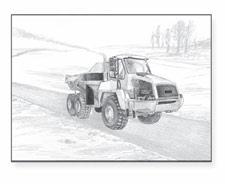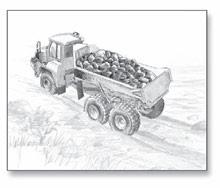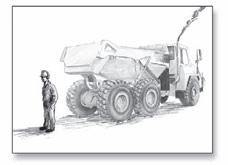
14 minute read
Operating the dump truck
2.1. Before operation
When the engine is running properly and the fluid pressures are within operating range:
1.Clean/defrost the windows before driving. 6.Sound the horn as alert.
2.Fasten the seatbelt before driving. 7.Depress the brake pedal.
3.Check that gauges and warning lights do not indicate any abnormalities.
OFF 8.Release the parking brake and confirm that the indicator light goes off.
4.Confirm low idle speed. 9.Select a suitable gear position at low idle (see item 2.3, Gear shifting).
5.Check that there are no persons or objects in front of the dump truck, or in the articulation area, before you drive off. 10.Release the brake pedal and increase the engine speed by pressing the throttle pedal downwards.
2.2. Warming up period
When driving off with a cold dump truck, operate the dump truck gently with reduced engine load and rpm to warm up until all gauges indicate operating range. This is important to avoid reduction of the dump truck’s performance potential.
2.3. Gear shifting
The transmission has automatic gear shift to match the travel speed. The shifting is electronically controlled and a lock-up clutch is fitted in the transmission to increase efficiency in all gears. Connection/disconnection is automatic but speed and engine load related.
Gear position N: Neutral gear position
The engine will not start if the gear selector is out of neutral position. When the gear selector is in neutral position it is always necessary to depress the knob on top of the selector to shift to forward or reverse position. Also, always depress the knob when shifting directly between forward and reverse direction.
Gear position V: Forward drive position.
The transmission shifts automatically between 1st and 6th gear, according to dump truck speed and engine load. The transmission will normally start in 2nd gear, if the conditions are heavy, it will automatically shift down to 1st gear.
Gear shift program: The gear shift program is controlled by the throttle pedal position. Shifting at low rpm happens when the pedal is partially depressed (part load mode). If the throttle pedal is further depressed, the gear shift will take place at higher rpm (full load mode). With the throttle pedal fully depressed, the gear shift will either be prevented or close to the maximum engine rpm (kick-down mode). When the throttle pedal is released and the engine brake or the engine and retarder brake is engaged, the down shift will take place at high rpm.
Automatic gear shift

continued overleaf
Manual gear shift Preselection of gears. The gears can be preselected by the driver as follows: Push the gear selector to the right (+) for upshifting or to the left (-) for downshifting. When a gear is preselected and the gear selector is pushed either to the left or right, the gear system will switch to manual gear shifting. The gear selector must then be pushed in order to change gear. When the selected gear is engaged, the transmission will only operate in this gear until the selector is pushed to another position or changed back to automatic gear shift by depressing the knob on top of the gear selector. When a gear is preselected and not engaged, the digits on the gear display will flash.

Manual gear shifting
To avoid repeated up and down shifting when driving in heavy conditions it is an advantage to use manual gear shift. When changing from automatic gear shift to manual gear shift, push the gear selector either to the left for downshift or to the right for upshift, or manual gear shift can be obtained by depressing the knob on top of the gear selector while driving in automatic. In manual gear shift mode the selector must be pushed in order to change gear. Preselection of gears is also possible in manual gear shift. When the selected gear is engaged the transmission will only operate in this gear until the selector is pushed to another position. If the dump truck is stationary, the selected gear will be engaged directly. To return to automatic gear shift while driving in manual, depress the knob on top of the gear selector.
CAUTION
With the dump truck stationary, do not engage a gear at high engine speed.

Engine and retarder brake mode
When the engine brake or the engine and retarder brake is engaged, the transmission will not shift to a higher gear if the speed increases at downhill driving, unless the throttle pedal is depressed (disengagement of engine and retarder brake).
Operating hints
Different types of terrain require different operating techniques.
Automatic gear shift
Manual gear shift
N
OFF • Use automatic gear shift, for normal travel.
• In terrain, before uphill/downhill driving, manually select a suitable position for the estimated speed in the area, avoid repeated up and down shift in hilly terrain.
• In manual gear shift mode, always drive allowing the lockup clutch to connect.
• Neutral position must not be selected during driving.
• The starter switch must NEVER be turned off (position 0) during driving, if you do not intend to stop the engine!
The engine has key stop and requires neutral position on gear selector to restart. • The knob on top of the gear selector is used for:
• Shifting from neutral to forward or reverse position.
• Shifting directly between forward and reverse direction.
• Changing between automatic and manual gear shift.
• When selecting a gear from the neutral position and when shifting between forward and reverse gears:
• Stop the truck and release the throttle pedal completely.
• Depress the knob on the top of the gear selector, select the desired gear and wait until the gear is engaged before increasing the engine speed.
• Do not operate the gear selector with the throttle pedal depressed. This will cause a big shock, and will also reduce the life of the dump truck.

2.4. Reversing (back-up) operations
1.Before reversing, make sure that no persons or objects are behind the dump truck or in the articulation area. 2.Stop the dump truck completely before selecting the reverse gear. 3.Depress the knob on top of the gear selector and place the gear selector in position R with engine running at low idle.
The transmission will always select 1st reverse. 4.Increase the engine speed. The reverse drive position has only manual gear shift between 1st, 2nd and 3th gear. The selector must be pushed in order to change gear. When a gear is engaged, the transmission will only operate in this gear until the selector is pushed to another position.
WARNING
• Be careful when reversing, the rear visibility is limited!

2.5. Normal operation
Always operate the dump truck with caution. Careful driving is recommended for safe and comfortable operation. Regulate dump truck speed in accordance with the ground conditions and surrounding environments. In manual gear shift mode, always drive allowing the lock-up clutch to connect.
If abnormal noise, vibration, smoke or odours occur during operation, check for possible faults and remedy. Check at regular intervals that all gauges are indicating normal values, and that no warning lights are on. • Transm. oil temp.: 50 - 105°C, max 120°C a short period • Transm. oil temp. at retarder brake operation: up to 140°C, max 150°C a short period
There are four different brake systems on the dump truck. Check the brakes every day to ensure function.
Service brake (main brake)
All hydraulic operated dry single disc brake on each wheel. There are two separate circuits. If a fault occurs in one of the circuits, the dump truck can still brake with the intact circuit. Self adjusting system.
Engine brake
Hydraulic operated, speed dependent brake which restricts exhaust flow. Efficient only when lock-up clutch is connected.
Retarder brake
Infinitely variable, hydrodynamic, wear resistant and speed dependent oil retarder fitted before transmission torque converter. The braking effect of the retarder brake depends on the engine rpm. High engine rpm gives high retarder braking effect.
Parking brake
Spring actuated, hydraulic released single disc brake on the rear prop. shaft. Self-adjusting system.

2.7. Engine and retarder brake operation
The engine and retarder brake operates automatically and are controlled by: • Throttle pedal position • Switch on the instrument panel • Throttle pedal position When the throttle pedal is fully released, lock-up connected and a gear is selected, the engine brake will automatically engage. • Switch on the instrument panel The retarder brake can be operated by depressing the retarder brake switch. The retarder brake will then engage if the throttle pedal is fully released, lock-up connected and a gear is selected.
The retarder brake will engage automatically if:
- the engine rpm exceeds 2100 rpm and the throttle pedal is fully released. This will happen regardless to the switch position. The brake will then disengage at 1950 rpm. - the brake pedal is depressed. The retarder brake will then be engaged until the throttle pedal is depressed or the lock-up is disconnected or the gear selector is moved out of gear position. This will happen regardless to the switch position. - the engine rpm exceeds 2600 rpm, to avoid overspeed of the engine. This will happen regardless to the throttle pedal and switch position.
NOTE
• Always use the engine brake or engine and the retarder brake when driving downhill for constant retardation.
• Both the engine brake and the retarder brake will automatically disconnect if the turbine rpm falls lower than 1200 rpm and will connect again when the turbine rpm rises above 1300 rpm.
• To avoid overspeed of the engine, the retarder brake will automatically engage if the engine speed exceeds 2600 rpm. This will happen ragardless to the throttle pedal an switch position.
Reduce the engine speed immediately!

2.8. Braking/stopping the dump truck
Learn to associate the braking requirements for loaded and unloaded machine. See also chapter 2. Safety Instructions 1.Release the throttle pedal. 2.Apply the engine brake or the engine and retarder brake. 3.Depress the brake pedal gradually, until desired deceleration is obtained.
4.When the dump truck is completely stopped, move the gear selector to neutral.
5.Apply the parking brake. • Hint: Always use the engine brake or the engine and retarder brake, this will result in increased lifetime of the service brake linings.
2.9. Emergency braking
If braking effect is lost in both brake circuits, the dump truck can be braked as follows:
1.Release the throttle pedal. 2.Apply the engine and retarder brake. 3.Set the parking brake to locked (on) position. 4.Move the gear selector to 1st gear manually as quickly as possible. 5.When the dump truck has stopped, immediately put wheel chocks under the wheels.
WARNING
After an emergency stop: DO NOT CONTINUE! The parking brake MUST be checked as well as the reason for the service brake failure! Consult your Moxy Dealer.

2.10. Steering
• The dump truck has 2 frames. The steering movement is created by articulation of the frames in relation to each other. The steering is fully hydraulically controlled and there are no mechanical links between the steering column and the steering cylinders. The steering circuit has priority over the tipping circuit, ensuring hydraulic oil available to the steering at any time. • The dump truck is equipped with an emergency steering system, which will deliver oil when the dump truck is in motion due to a ground-driven pump. It will then be possible to steer the dump truck if the engine stops. The steering movement will then be slower and the warning light for emergency steering will light. Repair the fault before operating the dump truck again!
NOTE
Mechanical endstops are fitted in the steering cylinders. Steering movement that will “hammer” these endstops must be avoided. Continuance of the steering actions against the endstops causes maximum pressure in the system - this must be avoided!
1
2
3 The dump truck has permanent 6-wheel drive with 3 differentials.
1. Front differential, automatic diff. brake (limited slip type)
Fitted to the transmission. Transfers the power to left and right front wheels.
The differential will automatically provide highest torque to the wheel which has best grip. The locking ratio is 45%, i.e. the differential is capable of compensating for a 1:2.64 difference in friction between left and right wheels.
2. Inter axle differential, 100% lockable torque divider
Integrated in the transmission. Transfers the torque by 1/3 to the front axle and 2/3 to the rear axle.
The differential lock can improve dump truck performance and should be used to avoid wheel spinning in severe conditions, i.e. slippery surfaces. Engage the differential lock before entering an area with a slippery surface, soft ground, or if the dump truck is stuck in the terrain.
The differential lock must not be used when driving on firm ground!
CAUTION
Use the interaxle differential lock to avoid spinning on front and rear axle.
3. Rear differential, automatic diff. brake (limited slip type)
Fitted in the rear axle housing. Transfers the power to left and right tandem drive.
The differential will automatically provide highest torque to the wheel which has best grip. The locking ratio is 45%, i.e. the differential is capable of compensating for a 1:2.64 difference in friction between left and right wheels.
• When travelling on gradients, consider the ground condition, and maintain a safe speed according to the grade of the path, the surface, degree of curves and road width. • Operate the dump truck sensibly and avoid crossgradient travel. Select a low speed and negotiate the terrain without exagerated steering movements and sudden braking.
• Before starting downhill, release the throttle pedal and slow down the dump truck to a safe speed for the downhill slope. Move the gear selector to a suitable position (1st, 2nd or 3rd). Rule:Select the same gear for operating downhill as you would for operating up the same hill.
• Always use the engine brake or the engine and retarder brake for constant retardation.
Long time engagement and unnecessary use of the service brakes can cause excessive wear and a possibility of loss of braking effect due to over-heated brake discs. • Do not under any circumstances drive the dump truck with raised body.
• Keep engine speed at the upper area, 1500 - 1900 rpm in heavy conditions and at hill travel. Select a manual gear position at steep hill travel.
• If use of the engine brake or engine and retarder brake is insufficient to keep the dump truck within a safe speed, reduce the speed by depressing the brake pedal. The travel must then continue in a lower gear with the engine brake or the engine and retarder brake applied. • Do not park or leave the dump truck on grades or slopes, the risk for spontaneous rolling is high!
• Pay attention to the transmission oil temperature when the retarder brake is applied. • ALWAYS keep the engine speed below max. allowed rpm when travelling downhill!
The retarder brake (emergency retarder) will automatically be engaged if the engine speed exceeds 2600 rpm.
This is to avoid overspeed of the engine.
• The dump truck must not coast with gear selector in neutral position.
• Engine speed must be reduced, and the dump truck must be stopped completely before changing between reverse and forward gears.
• Do not keep turning against the mechanical endstops, or force it into this point when making maximum turns.
• There is no braking effect from transmission when the engine is stopped.
• Select neutral gear and apply the parking brake when leaving the dump truck. Never leave the dump truck with a gear engaged! • Engine speed within 1500 1900 rpm with engaged lockup is recommended during driving.
• The retarder brake (emergency retarder) will automatically be engaged if the engine speed exceeds 2600 rpm, to avoid overspeed of the engine.
• Do not continue to operate the dump truck if a warning lamp lights, a gauge shows abnormal value, or if the warning buzzer sounds.
• Always operate the dump truck within the rated limits and carry out maintenance according to the scheduled program.
Overloading and lack of maintenance reduces safety and the life time of the dump truck is reduced.
• In case of problems with the dump truck, stop the vehicle and contact your local Moxy
Dealer to amend the fault.







